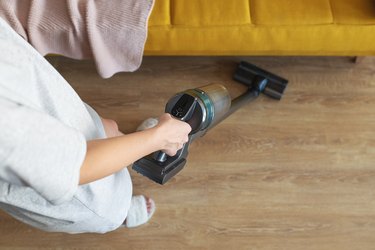Even if you're someone who loves to meticulously deep clean on a regular basis, that doesn't mean there isn't an army of dust bunnies in hiding just waiting to attack your allergies and your immune system. Dust particles are mostly made up of things like animal hair, human skin cells, dirt and pollen, and when there's a lot of dust particles in one area, it's almost impossible not to breathe in some of that.
When you're in a house with hidden areas full of thick layers of dust, the indoor air quality is going to be immediately affected. Keeping your house dust-free is especially important if someone in your home suffers from allergies or asthma.
Video of the Day
Video of the Day
Once you make it through this list detailing the top 10 places you're overlooking when you clean, then you can make a plan. Battling dust inside your home is an ongoing struggle, though. This is not one of those chores that can be done once and you're finished. Instead, it is all about setting up systems and schedules to ensure you don't miss any areas again. Your health starts with the air you breathe, and just a little cleaning can do a world of good in drastically improving the air purity.
Tackle one new space a day and take your time to make sure you get everything. Once you're finished, mark it on your calendar or set reminders on your phone. Get the rest of the household involved and make it a once-a-month event where everyone gets a different section of the house to tackle each month.
Here are 10 dusty places in your home that you need to clean more often.
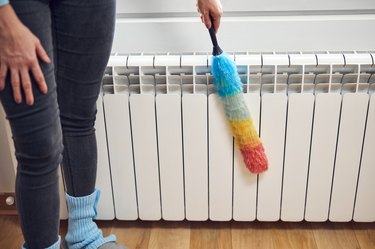
1. Baseboards
Your home is likely entirely encased in wood baseboards, but even though they are present in every area of the house, they are a commonly overlooked spot when it comes time to deep clean. You might think vacuuming and washing the floor is enough, but go ahead and take a closer look at your baseboards. You will probably be surprised at the amount of dust and grime on them.
Start by giving your baseboards a quick wipe with a dry microfiber cloth to get rid of any big tangles of dust or pet hair that might be sitting on the surface. You can also use your vacuum cleaner's brush attachment or even place a sock over the end of your broom handle to wipe them down if you can't bend over for too long. Once your baseboards are dust-free, go back over them with a damp cloth soaked in a gentle mixture of dishwashing liquid and water to help scrub away any leftover grime or dirt splatters. Repeat the process every few weeks as needed but just know that the more you spot clean in between, the easier your job will be later.
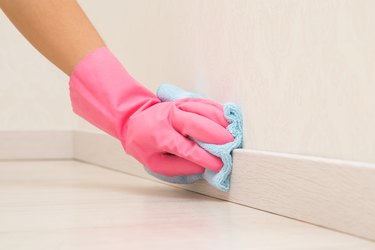
2. Ceiling Fans
When your ceiling fan is turned on and spinning so fast that you can't even see the blades, it can be difficult to see the amount of dust that is actually caked on the blades and around the light, but when you turn off the fan, it's a completely different story. The amount of dust can be quite shocking, especially when the ceiling fan is over your bed and you think about the tiny bits of dust that are being dropped down on you while you sleep and binge movies.
If the ceiling fan is low enough for you to reach by standing on a chair or step stool, then the best way to clean the blades is actually by using a pillow case. Slip the pillow case all the way onto the fan blade as if the blade were a pillow and then pull off the pillow case. All the dust will stay inside. Repeat for each blade. Then, you can gently wipe each one with a damp rag and a gentle cleaner without worrying about dust falling all over you.
If the fan is too high for you to safely reach it, just grab a duster with an extendable pole. This may send some dust flying down, so be sure to cover your furniture. It's also helpful to wear a mask when doing this to avoid inhaling any dust particles.

3. Air Filter
Your air conditioner is responsible for filtering the dust particles out of the air and delivering clear air to your entire house. If the filter inside your air conditioner is dirty, you'll be breathing in dirty air too.
If your air conditioner is the type with replaceable filters, be sure to change it for a new one at least every three months. Purchase multiple filters at a time and place reminders on your calendar so you'll never forget to change it again.
Air conditioners with reusable filters just need a quick rinse periodically, and they're good to go. Rinse the filter with your outdoor hose so that no dust goes down your drain. If the filter has a thick layer of dust, give it a quick once over with your vacuum attachment first.
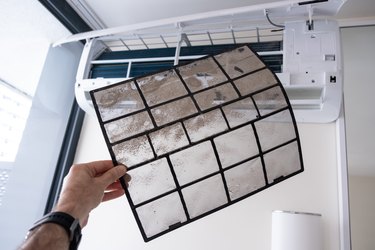
4. Bookshelves
It can be easy to overlook the dust collecting on your bookshelves, especially the dust particles that have settled on your knickknacks and the books themselves.
If the dust is particularly bad, it's best to remove everything from the shelves and wipe each item one by one. It may seem tedious, but having good air quality in your home is worth it. This is also a great opportunity to declutter. Having less items on your bookshelves means less surfaces on which dust can settle and an easier cleaning experience next time.

5. Bedding
Doing the basics, like changing your sheets and pillowcases, is a no-brainer when it comes to making sure your bedding is clean and fresh, but what about your actual pillows, blankets and throw pillows? Just because your pillows are covered by a pillowcase doesn't mean they're entirely protected from the skin cells we shed while we sleep, not to mention the sweat and drool. The same goes for your throw pillows and comforter.
Wash your pillows in the washing machine just like you would anything else. When it comes time to dry them, add a set of wool dryer balls to help fluff up the pillows. Your comforter may be too large for a standard washer and dryer, and if that's the case, just take it to the laundromat to take advantage of the industrial-size machines. This only needs to be done about once a month for the comforter and every six months for the pillows unless you spill something or get sick.

6. Light Fixtures
It's hard to spot the layer of dust accumulating on your lampshades and light fixtures when they're turned on, but get close and you might be surprised by what you find. Before you start, leave the light turned off for at least an hour to help prevent you from getting burned.
Once the light is cool to the touch, use a dry feather duster to take care of any loose particles lingering on your fixtures. For stuck-on grime, grab a slightly damp rag. Just make sure the rag is not dripping wet since water can easily get into the electrical components and cause serious problems.
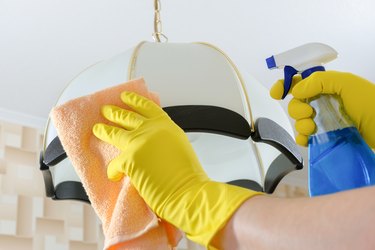
7. Area Rugs
Area rugs, even ones that are in low-traffic areas of your house, are hubs for germs and dirt. A quick pass with your vacuum cleaner can only get so many crumbs and hairs out of the rug. To up the ante and make your cleaning even more effective, sprinkle plain baking soda on the rug and let it sit for at least five full minutes before vacuuming to help pull out even more dirt than before.
Don't forget to pick up the area rugs to vacuum all the dirt that has made its way through the rug and settled on the floor. You might be surprised by how much can fall through even if you are someone who vacuums on a daily basis.

8. Windowsills
Windowsills are large, vertical surfaces, so it's naturally a prime place for dust to settle. They can easily be forgotten since windowsills are often covered by curtains and large pieces of furniture. Use a dry duster on the area first and then go back over it with a sponge and a spray bottle of your favorite streak-free cleaner. Clean the hard-to-reach grime out of the corners of your windowsills with an old toothbrush soaked in a mixture of dish soap and water.
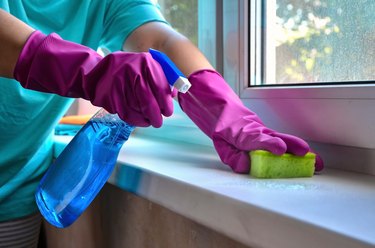
9. Indoor Plants
Your houseplants constantly help improve your air quality, add humidity to the environment and lift your mood without even trying. Now, it's your turn to say "thank you" and give your houseplants some extra attention the next time you water them. Start by taking a closer look at the leaves of each plant. While each variety of plant is different, most plant leaves can actually accumulate dust pretty quickly. This is why it's best to give them a quick wipe every few weeks.
Use a slightly damp paper towel but make sure you're only using water since the leaves would not appreciate being soaked in disinfectant cleaner. Gently run it across each leaf. Having a layer of dust on your plant's leaves means it won't be able to properly absorb the sunlight, and that means you'll soon have a wilting plant.
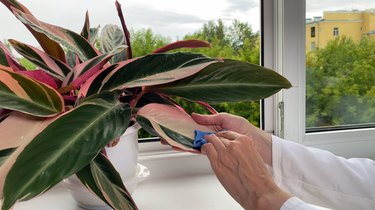
10. Under Furniture
Look under your dressers, beds and couches — these are places the dust bunnies love to hide. It can seem like such a pain to do the extra work to move chairs out of the way and get down on your hands and knees so that you can reach under all the furniture in your house with the vacuum attachment, but when you actually see what's under there, you'll definitely want to make it a point to do it more often. This isn't something that needs to be done every single time you clean your house, but it should be done on a regular basis, like every other month or so.
